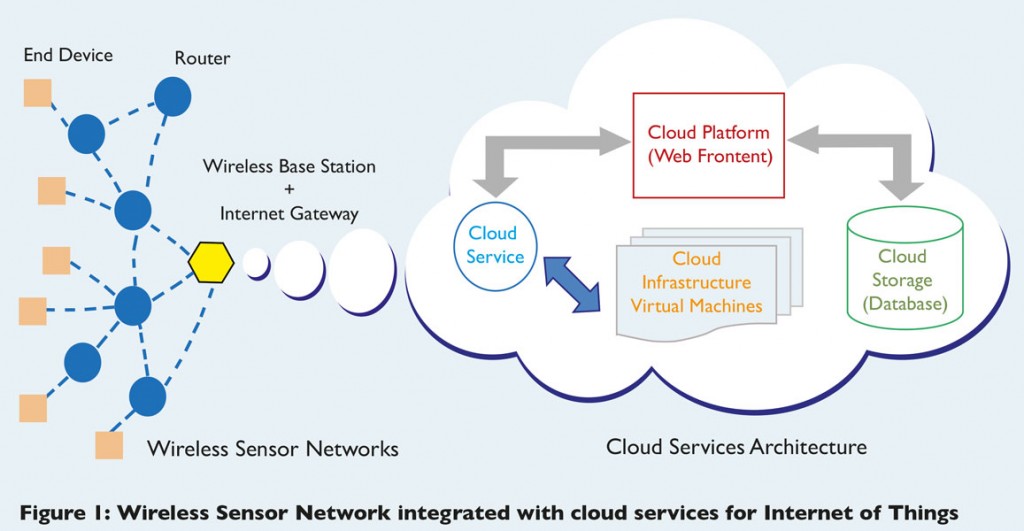By N. K. Suryadevara and S. C. Mukhopadhyay
Internet of Things (IoT) is all about the ability to sense things, understand and act according to the requirement of environmental conditions. The following information is about the potentials of IoT framework that everybody in business needs to realize, and its advantages over wide applications in daily activities.
Introduction
The developments of the Net Technology and Smart Sensor Systems have led to a new era of pervasive networks. An increase in users of the internet and advancements in ubiquitous computing enable the wide internetworking of everyday things. The Internet of Things (IoT) which is about “things” talking together, Machine-to-Machine (M2M) communications as well as person-to-computer communications by extending to the usage of “things”1. In the present technological scenario, the two terms, “IoT” and “Smart Things,” occur together frequently. The IoT gives rise to the smartness of interconnected things. In general, the words “IoT” and “Smart Things” follow each other in their respective application scenarios. The main objective of IoT is to have the ability to uniquely recognize, signify and access things anytime and anywhere in an internetwork, and this can allow the controlling of any “things” in an ideal situation.
The adaptability of IoT modelling in day-to-day life activities makes for a variety of applications. The design and development of these applications depend on many different technologies that correspond to its realization for daily use. Initially, the use of the IoT was driven by the management of information through tags of Radio Frequency Identification (RFID) for tracking things, supervision and controlling of things, and automation of electronic payments in trade markets. The advancement of hardware technologies has brought up the development of the IoT by means of miniaturizing wireless devices, smart sensors/actuators and micro-controllers. Those technological advancements have inspired many schemes for refining the software of embedded devices. These have led to efficient optimization of M2M communications, providing very feasible and practical IoT-related applications. In the present context, a paradigmatic approach for IoT applications has been presented to provide smart spaces and consisting of numerous independent Smart Things. The future internet focuses on integrating real world services provided by the IoT framework into a “mashup” of traditional services1.
[ms-protect-content id=”9932″]
Applications of IoT
The following is an overview of the important IoT application domains presently recognized by the research and industry communities:
Monitoring of Everything: “Every Thing in this world will be connected to each other via the internet so that we can know anything we want to know”2.
Environmental Monitoring: The importance of environmental technology has become a vital field of research and development for ecological progression worldwide. The environmental/earth monitoring systems receive information such as air/water pollution data, lake/river pollution information, land monitoring statistics and plant/crop growth indicators. Applications such as traffic monitoring, lighting, pollution monitoring, chemical hazard detections, earthquake detection, flooding detection, volcano eruption forecasting and weather forecasting are becoming hugely importance to society3. These applications can be realized using a low-cost, reliable and efficient system through an IoT framework.
Smart Cities: A wide set of IoT applications strive to create smart cities that are more sustainable, safe, and enjoyable using IoT models. Cooperation among citizens, institutions and companies is very much required for the utilities and service providers to efficiently perform IoT operations. The applications of interest range from systems supporting urban mobility and its safety such as smart parking, traffic congestion, intelligent transportation systems, monitoring or optimizing assets and critical infrastructures in cities for structural health, smart lighting, smart roads systems monitoring and protecting citizens’ quality of life using noise urban maps and waste management3. Intelligent buildings and smart greenhouses can be controlled and optimized via wireless sensors and actuators in the framework of the IoT.
Smart Agriculture/Animal Farming: Smart agriculture focuses on monitoring the soil used for growing agricultural products, plants, greenhouses, or the environmental conditions (e.g., weather)3. Closely related to smart agriculture is smart animal farming which tries to enhance the productivity of animals for meat and related products (e.g., milk, eggs) by monitoring animal health conditions at different stages, animal tracking and identification (also used for product traceability), and living environment3.
Smart Transport/Logistics: Smart transport supports good monitoring during transport, e.g., in trucks or cargo ships, and supports good detection and tracking in warehouses 3. Mobile robotics applications in the industry are very much supported by IoT in which mobile robots interact with fixed IoT infrastructures, e.g., to support internal logistics in manufacturing plants3.
Industrial Control: Industrial control is one of the main application domains for IoT technologies (e.g., for the remote monitoring of manufacturing lines through SCADA systems) [3]. These systems are typically deployed in manufacturing or process industries in order to remotely check machineries (e.g., M2M applications), diagnose the status and position of moving vehicles or robots, or to monitor the conditions of the manufacturing environment (e.g., air quality monitoring in food processing industries)3. These systems help the transition of industrial automation from custom, closed developments to more flexible internet-oriented schemes integrated with enterprise systems. They simplify data-intensive applications like real-time tracking or predictive maintenance. Manufacturing applications leverage autonomous M2M interactions to monitor and optimize production lines3. Preventive action can be taken in advance and awareness levels will increase.
Home Automation and Health Care Monitoring: A smart home monitoring system with distributed wireless smart sensing units and effective data processing system can be realized with the help of an IoT framework4. Additionally, the system can be used for monitoring the behaviour of inhabitants and evaluate the longitudinal elderly healthcare assessment. Thus, the IoT framework can fuse the smart sensor data of household appliances usages and execute multiple tasks of IoT for the smart home monitoring system.
IoT Framework: Wireless Sensor Networks (WSN) based data fusion interpretations were implemented from the start of the IoT framework modelling. The reasons for using WSN with IoT are i) low-cost, ii) long-term adaptable sensing and actuation abilities, and iii) dispersed resilient communications in the framework.
Key modules of the IoT framework implementation
Availability of Internet Everywhere: Providing an internet facility is a financially costly resource, and it may be an extremely valuable proposition to think of the internet for other applications. An internet connection is the backbone for the IoT framework and can be used to transmit the sensing data collected from widely distributed regions.
Design and Development of Smart Sensors and Measurements Techniques for IoT: Smart sensing systems that interconnect everyday home systems and their environmental monitoring systems can be designed and developed for the IoT framework. For effective transmission and high throughput of data across the WSN-IoT framework, the measurements of smart sensor data types, number of sensing channels, and the sensor data sample intervals are to be optimally configured. Most applicable network protocols followed in WSN is the IEEE 802.15.4 (ZigBee) or 6LowPAN for effective and reliable communications. ZigBee was designed for use in local networks such as home automation environments. However, ZigBee/6LowPAN do not directly communicate with servers on the Internet without proper integrating mechanisms. Remote management and controlling of ZigBee/6LowPAN based devices over the IoT can be mechanized by following certain architectural design strategies of the IoT gateway4.
Smart Sensor Data Fusion and Data Storage UsingCcloud Management for IoT Framework: One of the key functions of the IoT framework is providing internet services based on the data initiated from Smart Things. In general, the IoT framework integrating the smart wireless sensing systems and their corresponding applications is depicted in Fig.1 . The full potential and most viable application of the IoT can be realized by the combination of ubiquitous smart sensing systems with a cloud infrastructure. The advantage of the IoT framework with cloud computing is that it is highly scalable and offers flexibility in isolating the logical structures and its associated costs5. Sensing systems can link their communications network and transmit the sensing data using a storage cloud management mechanism. Efficient real-time data mining or artificial intelligence tools can be provided for extracting useful information and translating into a corresponding knowledge base4. Also, computer graphics developers can provide a range of visualization softwares for viewing the real-time IoT data through web applications. The integrated IoT and cloud computing infrastructures have the full potential of remote monitoring and controlling smart sensing systems as services. The data generation processes, tools considered, and the visualization procedures created during the application execution of IoT disappears into the background, tapping the full potential of the IoT in various application domains5. It can be observed from Fig.1 that the cloud computing infrastructure integrates the distributed smart sensing systems by providing scalable storage, computation time and other tools to build new IoT businesses.
Data Analytics related to IoT: The IoT framework should be capable of supporting i) real-time sensor data acquisition directly from sensing systems or be able to retrieve the data from the databases in near real-time, ii) easy handling of real-time data analysis logic methods that process the streams of sensor data in the form of raw data processing or processed data using cloud computing facilities and iii) recognize anomalies on the sensor streams, and send the outputs in a scalable manner to a visualization process5. The blend of IoT applications and cloud computing facilities will harness the power of distributed computing.
Challenges and Opportunities
Some of the major IoT challenges are privacy, data storage, smart sensing instrumentation and measurements, data analytics, and visualization of real-time data in the IoT enabled application. Apart from having robust cloud computing facilities, the challenges related to WSN such as the optimal number of sensing devices required for monitoring applications, security of the sensor data, protocols to be considered for low power consumption, optimum data compression, and Quality of Service (QoS) persist in the design and deployment of the IoT framework in the present business situation. In the near future, Smart Things should be easily deployed in the form of plug-n-play in any context using the IoT framework5. The internetworking mechanisms of Smart Things in the IoT framework are crucial with respect to the standardization of communication protocols. It should be mentioned that to safeguard everything in the future, electrical power, computing systems and the internet should be ensured as a fail-safe operation, and this may be a huge challenge. Additionally, changing dynamics in the global economy can look into the issues related to security and misuse of data/information, and formulate appropriate protocols.
About the Authors
Nagender Kumar Suryadevara received his B.Tech. degree from Sri Krishnadevaraya University, India, in 1996 and his M.Eng. degree from Madurai Kamaraj University, India, in 1998. At present, he is working toward the Ph.D. degree at the School of Engineering and Advanced Technology, Massey University, Palmerston North, New Zealand. He is currently involved with the development of software systems for home monitoring project using WSNs. His current research interests include domains of wireless sensor networks, the Internet of Things, and real-time data mining.
Subhas Chandra Mukhopadhyay is currently a Professor of sensing technology with the School of Engineering and Advanced Technology, Massey University, Palmerston North, New Zealand. He has more than 25 years of teaching and research experience. He has authored/co-authored over 300 papers in different international journals and conference proceedings, and as book chapters. Prof. Mukhopadhyay has been the recipient of numerous awards throughout his career and has attracted over NZ $3.6 M on different research projects. He is a Fellow of IEEE and IET.
References
1. S. C. Mukhopadhyay, Ed., Internet of Things: Challenges and Opportunities, vol. 9, Switzerland: Springer International Publishing, ISBN 978-3-319-04223-7 (eBook), 2014.
2. S. C. Mukhopadhyay and N. K. Suryadevara, Internet of Things: Challenges and Opportunities, vol. 9, S. C. Mukhopadhyay, Ed., Switzerland: Springer International Publishing, pp. 1-18, 2014.
3. Z. Song, M. T. Lazarescu, R. Tomasi and L. Lavagno, “High-Level Internet of Things Applications Development Using Wireless Sensor Networks,” in Internet of Things:Challenges and Opportunities, Switzerland, Springer International Publishing, pp. 75-109, 2014.
4. S. T. Kelly, N. K. Suryadevara and S. C. Mukhopadhyay, “Towards the Implementation of IoT for Environmental Condition Monitoring in Homes,” IEEE Sensors Journal, vol. 13, no. 10, pp. 3846 – 3853, 2013.
5. J. Gubbi, R. Buyya, S. Marusic and M. Palaniswami, “Internet of Things (IoT): A vision, architectural elements, and future directions,” Elsevier: Future Generation Computer Systems, vol. 29, no. 7, p. 1645–1660, 2013.
[/ms-protect-content]
Disclaimer: This article contains sponsored marketing content. It is intended for promotional purposes and should not be considered as an endorsement or recommendation by our website. Readers are encouraged to conduct their own research and exercise their own judgment before making any decisions based on the information provided in this article.


























![“Does Everyone Hear Me OK?”: How to Lead Virtual Teams Effectively iStock-1438575049 (1) [Converted]](https://www.europeanbusinessreview.com/wp-content/uploads/2024/11/iStock-1438575049-1-Converted-100x70.jpg)






